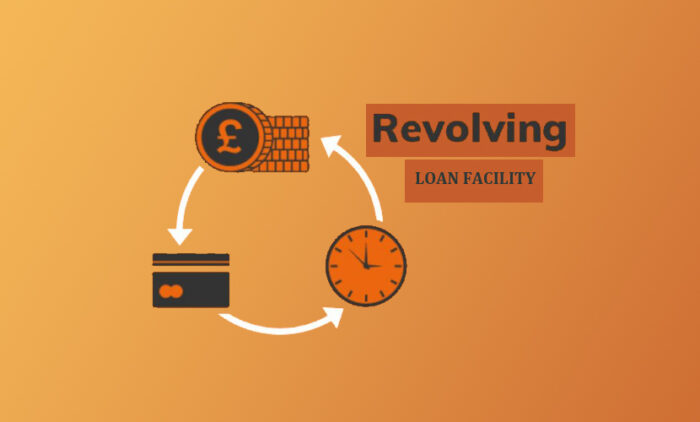A revolving loan facility, also known as a revolving credit facility or simply a revolver, is provided by financial institutions.

This type of credit enables borrowers to withdraw funds, repay them, and then withdraw again as needed. It is considered flexible because it offers a financing option that accommodates repayment and re-borrowing.
However, unlike a term loan, which provides funds with a fixed payment schedule, a revolving loan allows borrowers to repay or withdraw funds within a specified period.
How Does A Revolving Loan Facility Work?
Revolving loan facilities work on the concept of loans that automatically renew, making it convenient for businesses to access funds as needed throughout the agreement period.
You can make multiple withdrawals and repayments whenever additional funds are required. Whether you utilize the facility frequently depends on your business’s unique needs.
In addition, interest rates are typically fixed and paid daily, aiding in effective cash flow management. The withdrawal limit is usually determined by your business turnover, often equivalent to one month’s value.
Furthermore, lenders also assess your business credit history and financial status when making decisions.
Generally, these facilities are short-term, lasting anywhere from six months to two years. If you maintain timely repayments and meet the lender’s criteria, you may have the option to extend the facility.
Features Of A Revolving Loan Facility
A revolving loan facility provides borrowers with substantial flexibility in terms of repayments and re-borrowing.
Unlike fixed-rate loans, the interest rate for a revolving loan facility is typically variable, similar to a line of credit.
This type of facility allows businesses to borrow funds as needed to support various working capital requirements, such as covering payroll and paying invoices. However, here are some of its other features below:
Cash Sweep
In many cases, a revolver includes a cash sweep provision. It implies that any significant free cash flow generated by a company is utilized by the bank to pay the outstanding debt of the revolver ahead of schedule.
It ensures a quick rate rather than contributing the cash to shareholders or investors. Also, it reduces the credit risk and liability associated with depleting cash reserves for non-essential purposes.
Interest Expense
Interest on a revolver is calculated only on the amount withdrawn, not on the entire credit line. The unused portion of the credit line remains available for use, offering inherent flexibility and convenience.
However, the interest rate is comparable to the company’s long-term debt rate. Although it may vary, depending on the bank’s prime rate plus a premium, with adjustments based on the company’s creditworthiness.
Maximum Amount
A revolver provides a solution for managing cash flow when it’s insufficient. While there’s a maximum borrowing limit set by the bank, this limit may undergo an annual review.
Additionally, decreases in a company’s revenue may prompt the bank to lower the maximum amount to mitigate default risk.
However, favorable credit, strong financial performance, and consistent payments may lead to an increase in the maximum limit over time.
Commitment Fee
Starting a revolving credit facility may require a commitment fee charged by banks. It compensates the lender for maintaining access to a potential loan without activating interest payments until the revolver is utilized. This fee structure can be either a flat fee or a fixed percentage.
Reusability
As the name suggests, a revolver allows for repeated use once the outstanding amount is repaid. This cycle of withdrawing, spending, and repaying can continue until the arrangement expires, marking the end of the revolver term.
However, unlike an installment loan, it requires reapplication after full repayment. Nevertheless, a revolver offers ongoing usability without the need for a new application.
Advantages Of A Revolving Loan Facility
Revolving credit offers numerous potential perks and advantages. They include:
Flexibility
Because of its flexibility, revolving credit can aid businesses in accessing funds whenever necessary, serving as a valuable financial resource.
Pay For Utilization
Revolving credit entails paying interest solely on the amount you use. Unlike term loans, where interest accrues on the total credit amount, with revolving credit, charges apply only for the days you withdraw funds.
Quick Evaluation
Enrollments for revolting loan facilities are regularly handled quickly because of the software utilized by numerous lenders. Also, you could obtain the main funding on the same day you enroll.
Disadvantages Of A Revolving Loan Facility
While they have various advantages, revolving loan facilities also have numerous disadvantages that should be considered. They include:
High-Interest Rate
Revolving credit has higher interest rates compared to alternative funding options. Certain lenders impose extra interest fees for late repayments, potentially leading to cash flow challenges for your business.
Fees
Providers of revolving credit commonly impose fees for establishing the facility, thereby adding supplementary expenses to the arrangement.
Personal Guarantee
Securing revolving credit may mandate individuals provide a personal guarantee. This implies that you assume personal responsibility for the debt if your business fails to meet repayment obligations.
Impact On Credit Score
Similar to various debts, missing repayments or making late payments on borrowed funds, including revolving credit, can affect your business’s credit score. This could potentially restrict future access to funding options.
Eligibility
Revolving credit is typically restricted to limited companies, only for sole traders seeking access to this form of funding.
How To Choose The Best Revolving Loan Facility
Before committing to a revolving loan, it’s important to assess if it suits your business needs. Explore available funding options and consider seeking advice from independent finance experts.
However, keep in mind that a revolving loan facility is not intended for extended-term use, and alternatives such as business loans may offer more favorable terms with lower interest rates.
If you determine that revolving credit aligns with your business needs, research various lenders online, review customer feedback, and consult other business owners for recommendations.
Furthermore, some business membership organizations may have partnerships with revolving credit providers.
Compare fees, interest rates, and eligibility criteria carefully, and ensure a clear understanding of repayment terms and any potential penalties for late payments.
Conclusion
For business owners facing fluctuating income, a revolving loan facility can be a valuable resource to meet payroll obligations or address unexpected expenses.
Establishing such a facility with your bank could prove to be a prudent decision for enhancing your business’s financial stability.



